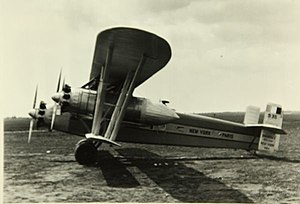Sikorsky S-35
| Sikorsky S-35 | |
|---|---|

|
|
| Type: | Record aircraft |
| Design country: | |
| Manufacturer: | |
| First flight: |
1926 |
| Commissioning: |
1926 |
| Number of pieces: |
1 |
The Sikorsky S-35 was an American three-engine biplane manufactured by the Sikorsky Manufacturing Company . The S-35 was developed by Igor Sikorsky for an attempt to win the Orteig Prize of 25,000 US dollars in the non-stop Atlantic crossing .
history
The S-35 was a one-and-a-half-decker with a fixed tail landing gear and was the further development of the twin-engine S-29A, which was built from spring 1924.
The pilot René Fonck convinced the aircraft engineer Igor Iwanowitsch Sikorsky, who had emigrated from Russia to the USA, to implement various technical improvements to his Sikorsky S-35, which was intended for the Atlantic flight. The machine was then rebuilt and received a number of additional tanks as well as an auxiliary landing gear that was attached under the fuselage and that could be released after take-off. The S-35 had three 425 HP (317 kW) Gnome-Rhône Jupiter 9A radial engines. The first flight, conducted by Fonck and Igor Sikorsky, took place on August 23, 1926 at Roosevelt Field in Mineola , New York .
Sikorsky began a series of additional test flights, but none of the test flights were satisfactory at the maximum weight due to the amount of fuel required for the non-stop flight. Sikorsky then wanted to postpone the Atlantic crossing until early 1927. However, the Frenchman Fonck insisted on an earlier date and the S-35 was hastily prepared and provided with an additional landing gear.
accident
René Fonck started with his co-pilot Lieutenant Lawrence Curtin, the radio operator Charles Clavier and the Sikorsky mechanic Jacob Islamoff on September 21, 1926 in front of a large crowd on Roosevelt Field. The S-35 had just gained the necessary speed on the 1,500 meter long runway to take off when the landing gear broke. Fonck could no longer bring the aircraft under control and the machines fell down a slope at the end of the runway and went up in flames. The two pilots were uninjured, but the radio operator and mechanic were killed. The press at the time reported that the machine, valued at around $ 100,000, was uninsured.
Charles Lindbergh took off from Roosevelt Field at 7:54 a.m. on May 20, 1927 and won the Orteig Prize.
Technical specifications
- Crew: 4
- Length: 13.41 m
- Upper span: 30.78 m
- Lower span: 23.16 m
- Height: 4.88 m
- Wing area: 73.8 m 2 (upper wing), lower area unknown
- Empty weight: 4,400 kg
- Take-off mass: 9,100 kg (the exact take-off mass on the day of the accident is not known)
- Powerplant: 3 × Gnome-Rhône Jupiter 9A radial engines, each with 425 HP (317 kW) power
- Propeller: 3 × two-bladed, diameter 3.20 m
- Service ceiling: 5100 m
Web links
- Pictures of the three-engine S-35
- Sikorsky S-35: The plane that should have beat Lindberg. Video with numerous detailed shots of the S-35's history
- Photo of the engine cowling
- The Sikorsky p.35 - The Three-Engined (Jupiter) Transatlantic Biplane on flightglobal (accessed January 25, 2014)
